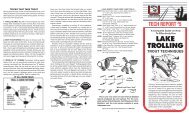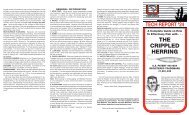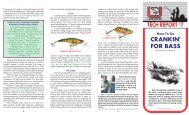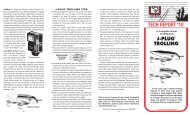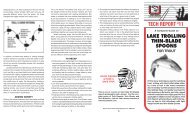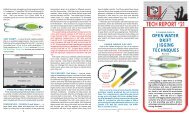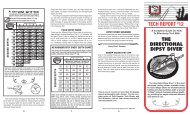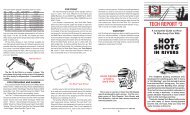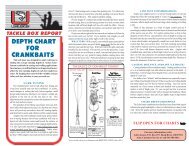tech report #15 - Let's Catch Fish
tech report #15 - Let's Catch Fish
tech report #15 - Let's Catch Fish
- No tags were found...
You also want an ePaper? Increase the reach of your titles
YUMPU automatically turns print PDFs into web optimized ePapers that Google loves.
TEMPERATURE AND OXYGENIn large fresh water lakes and reservoirs time of day isn’t nearlyas critical as locating the preferred temperature level for the fishspecies you are seeking and the thermocline. Lakes stratifyinto three separate layers with the onset of warm weather andgenerally stay that way until fall. The middle layer of water,where there is a large concentration of dissolved oxygen, baitfishand therefore predator fish is called the thermocline and cangenerally be found from 10- to 80-feet down. This is not onlyan oxygen-saturated layer, but a temperature layer as well andfish relate to it as both a comfort zone and a zone where theirbody metabolism functions efficiently.The peak feeding and optimum temperature for coho andchinook salmon is 55-degrees with an active range of 44 to58. For lake trout, peak feeding and optimum temperatureis 50-degrees with activity from 43 to 53. For steelhead trout,optimum temperature is between 50- and 55-degrees withactivity from 40 to 75. Brown and rainbow trout have an optimumtemperature preference between 55- and 60-degreeswith activity from 44 to 75. Striped bass exhibit a range oftemperature preference from 60- to 78-degrees with theoptimum temperature between 70 and 72.<strong>Fish</strong> rarely venture out of these preferred temperature zones,except to catch a meal and then will return quickly. One thingto remember when fishing temperature layers such as the thermoclineis that it can change from day to day because of windand/or wave action and you’ll have to locate it each time out.& COLORS<strong>Fish</strong> definitely see color and/or shades of color and can be veryfussy about it. One of the big advantages of trolling with spoonsis the wide variety of specialized finishes available . . . there’s acolor to fit every angling situation.GENUINE SILVER PLATE - The ultimate in metal finishes,Genuine Silver Plate, is available on the Coyote Spoon andDiamond King. This finish produces a highly reflective shine notachievable with nickel or chrome plating . . . it simply reflects amuch higher percentage of light, like a baitfish, under a varietyof different light conditions and at different depths.FISHSCALE - The natural, iridescent look of baitfish scaleshas been captured on Coyote and Loco spoons. This finish hasproved extremely productive at all depths.EVERGLO FINISHES - The Loco is available in a Glo/Fluorescent Green Stripe finish which is particularly effectivein deep water.HOT TAIL FINISHES - The Krocodile, Coyote and DiamondKing now are available in special Hot Tail finishes including Pearl/Green Chartreuse, Nickel/Fire, Brass/Fire and Chartreuse/Fire.These finishes focus strikes to the rear of the lure, where openhooks ensure more and better hookups.ADDITIONAL TIPSOne of the easiest and least complicated things you can do toimprove your fishing results is to make sure all hook points aresticky-sharp. The majority of lost fish can be traced to dull hooks,which prevented proper penetration into the fish’s mouth. A smallfile such as Luhr Jensen’s is the absolute best hook sharpeningtool available. Hold the file parallel to the hook point and, withgentle one-way strokes, remove a small amount of metal from atleast two sides of the point. This results in both a sticky-sharppoint and a knife-like cutting edge.TECH REPORT # 15A Complete Guide on HowTo Effectively <strong>Fish</strong> with . . .TROLLINGSPOONSFOR FRESHWATERSALMON/STRIPEDBASS/TROUTGOODFISHINGAND HAVE ASAFE TRIP!SPECIALIZED FINISHESYou should always use a premium quality monofilament linesuch as Sufix ® which has superior knot strength, small diameterin relation to pound test and which is abrasion resistant.Purchase a quality depth sounder, which will help in locating fishas well as prime underwater fish-holding structure which can’totherwise be detected.This is one of a series of more than 25 detailed <strong>report</strong>sproduced by Luhr-Jensen. For the complete series ofTech Reports, Tech Sheets and Tech Bulletins, visit theLuhr-Jensen website at www.luhrjensen.com.Visit us on the web at www.luhrjensen.com #8822-013Revised 120304 Litho in U.S.A.Trolling with spoons is a <strong>tech</strong>nique practiced and enjoyedeveryday by thousands of fresh water anglers acrossthe country. It’s an easy-to-learn and use methodwhich is particularly effective in lakes and reservoirs forlarge fish such as coho and chinook salmon, brown,cutthroat and lake trout, striped bass and several varietiesof rainbow trout including landlocked steelheadand Kamloops.© Luhr Jensen & Sons, Inc.678<strong>#15</strong> Trollingforspoonsfreshwater_2008.indd 1 12/9/08 1:46:49 PM
LUHR JENSENSpoons are effective because they closely resemble and imitatethe action of baitfish . . . the primary food source of predatorygamefish.Anglers who employ trolling as their primary <strong>tech</strong>nique andunderstand fish and their habits regularly out fish anglers usingother <strong>tech</strong>niques. The reason is simple: You cover a large areaof water thoroughly in a short time, pinpointing concentrationsof fish or contacting scattered groups with minimum effort.Trolling allows you to cover more water faster, easier and morecompletely than any other fishing <strong>tech</strong>nique.A spoon should wobble from side-to-side and will produce itsbest all-around, fish-catching action when trolled at speedsbetween the slowest that produces a wobble and the fastestdarting action that does not cause the lure to revolve or spin.For fast trolling try the Diamond King or Krocodile ® . Mediumspeed trolling spoons include the Coyote and Needlefish ® .For general trolling at all speeds, the Loco ® and Super Duper ®are excellent choices.The best trolling spoons are lightweight and thin whichwill provide the most erratic, darting baitfish action in thewater. Spoons such as the Krocodile and Super Duperare manufactured in casting and trolling models and it isimportant that you select the lightest weight models. Forexample, one die may stamp several different thicknessesof a spoon, such as the No. 5 Krocodile, which produces3/4-, 1-, 1 1/2- and 2 1/2-oz. models. For trolling, you wouldchoose the lighter 3/4- or 1-oz. size.Diamond KingKrocodile ®SPOON TROLLING RIGSFollowing are several diagrams of proven ways to rig a spoonfor trolling. Note that dodgers often are used as attractors inconjunction with spoons when fish are scattered or are in deepwater.FLATLINE - With the surface or flatline <strong>tech</strong>nique, the spoonis tied directly, via its attachment device, to 8- to 20-lb. test mainline. No additional weights are used or, at most, a small 1/8- to1/2-oz. keel-type sinker may be placed 6 feet up the line fromthe spoon. The spoon is let out behind your moving boat 50-to 200-feet and the troll begun. This <strong>tech</strong>nique is particularlyeffective when trout, steelhead, stripers or salmon are feedingnear the surface, especially during low light periodsTO ROD750' to 150' 8# - 20# LINE COYOTE SPOONSHALLOW TO MEDIUM - With the addition of a keel sinker4- to 6-feet up the line from the spoon, shallow to medium depthscan be trolled effectively. Sinker weights, depending upon thedepth desired, usually run from 1- to 8- ounces with main linetesting from 12- to 30-pounds. As in flatlining, let out 50- to200-feet of line behind your moving boat and begin the troll.7TO RODDIVERS - One effective way to get a spoon or spoon/attractorrig deep without lead weights is with a diving sinker such as thePink Lady, Deep Six, Double Deep Six, Dipsy Diver ® orJet Diver. The Dipsy Diver is particularly unique diving sinkeras the lead weight in its base plate can be shifted in degrees toproduce starboard, port or behind the boat running. With theDipsy ® you now can troll off to either side of the boat withoutinterfering with flatlines or downrigger lines and cover an extremelywide swath of water. Divers also act as fish attractorsdue to their color and shape. Standard rigging with a diver is4- to 6-feet of leader between spoon and diver and 20- to 30-lb.test main line to your rod.You can attract more fish to your spoon and enhance spoon actionby adding a dodger to your outfit. Dodgers should be riggedin-line, 18- to 30-inches from your spoon and 48-inches fromyour weight or diver (see illustrations). The size 000 and 020 arethe most popular for bigger fish such as chinook, coho and laketrout. For smaller fish like trout, try the 030 or 040 sizes.TO RODTO RODKEEL SINKER4' - 6' LEADER12# - 30# LINECOYOTE SPOONDIPSY DIVER ® & SPOON48" LEADERDIPSY DIVER ®WITH "O" RING4' to 6' LEADER#000 DODGER20# to 30# LINEMANISTEE COYOTE SPOON18" to 30" LEADERDOWNRIGGERS - Spoons often are fished off a downrigger,either by themselves or in conjunction with a dodger or flasher.With a downrigger you will be able to work all depths and willhave the added advantage of no weights between you and thefish once hooked. Anglers who troll spoons by themselvesbehind a downrigger, especially when seeking wary fish suchas chinook or lake trout, often prefer 10- to 30- feet (some asmuch as 40 to 60 feet) between the line release and spoon.Dodgers can be used as attractors in conjunction with aspoon behind a downrigger with good results. Size #000 or #001Jensen Dodgers are recommended. Allow 18- to 30- inchesof leader between spoon and dodger. Shorter leaders producemore frantic and faster spoon action while longer ones result inslower action.DOWNRIGGER SETUPSIMPROVED CLINCH KNOTMANISTEE COYOTE SPOONDOWNRIGGER/DODGER/SPOON18" to 30"LEADERDOWNRIGGER & SPOON10' - 20'8# - 20# LINE20# LINE6' - 10'Flashers are yet another kind of attractor that can be used witha spoon behind a downrigger. Flashers such as the Abe & Alproduce a deliberate, slow roll which is often favored by speciessuch as chinook and lake trout. Because of the rotating natureof the flasher, spoons trailed behind must have more leader thanwith dodgers, commonly 30- to 48- inches.FISH PREFERENCESCertain fish species, particularly larger fish, display specificpreferences when it comes to trolling spoons and/or colors. Thefollowing species-by-species breakdown will provide valuableinformation you can apply immediately.COHO SALMON - When the temperature is right in fresh water,coho salmon are surface or shallow water oriented and canbe found, for the most part, at depths less than 50 feet. Cohoespecially like fast action spoons and the added action of small#000 or #020 dodger ahead of a spoon (see rigging diagram).Specific spoons geared for coho fishing include the Coyote, and003 Loco.CHINOOK SALMON - When compared with coho, freshwater chinook prefer deeper water. They often shy away fromunnatural movements in the water so longer leaders often areused. Proven chinook spoons include the Loco, size 050 Coyoteand Diamond King. These spoons all have a deliberate, wobblingside-to-side action when trolled at medium to fast speeds.Because chinook are often found deep, blue or green-paintedfinishes are effective, as are glow-in-the-dark patterns. Silveror Pearl also are known chinook color favorites.LAKE TROUT - Lake trout prefer slow, deliberate-actionlures and/or attractors. Popular spoons include the Krocodileand Loco with top colors being Genuine Silver Plate, Pearl,Nickel/Blue Stripe, Chartreuse/Fire Dot, Glo Green and 50/50Hammered Brass/Nickel. Lake trout generally lie close to thebottom or in the lower level of the thermocline.BROWN TROUT - These fish are slow to react and very waryof any unnatural movement or noise. They often are boat shyso let out more line when trolling (100- to 300-feet). Their dietconsists primarily of small fish so spoons are a natural when itcomes to fishing for them. Browns show a definite preferencetoward natural bait finishes such as Rainbow Trout and BrownTrout. Other popular finishes include Brass/Gold Prism-Lite,Brass/Fire Stripe and Brass Bikini. An excellent spoon touse is the Krocodile.RAINBOW TROUT - These fish and their cousins, landlockedsteelhead and Kamloops, normally are fast-moving and are foundscattered at different depths in lakes and reservoirs. They willconcentrate where food and/or oxygen sources are located andfrequently can be found feeding near the surface during low lightperiods. Metal finishes such as Chrome/Blue, Chrome/Fireor Chrome/Green, Brass/Fire or painted finishes such asChartreuse/Fire Dot, Rainbow Trout or Brown Trout oftenproduce strikes. Genuine Silver Plate is a finish which hasproved irresistible to rainbow, steelhead and Kamloops. Thesefish strike at medium to fast trolling speeds with spoons suchas the Krocodile, Loco, Canadian Wonder, Super Duperand Coyote solid bets for success.STRIPED BASS - Fresh water striped bass can be found inalmost every state and their popularity among sport anglerscontinues to increase. Stripers are much like salmon and largetrout in their eating habits, preferring to dine on baitfish such asshad or smelt. Stripers commonly are found in 20- to 40-feet ofwater during most of the day. They are constantly on the moveduring daylight hours and roam open water in search of baitfishschools. However, during early morning and late evening lowlight periods, stripers frequently will be in the shallows chasingschools of bait. Blues and greens in combination with nickel(either hammered or plain) are proven striped bass colorsfor medium to deep water trolling.2 3 4 5<strong>#15</strong> Trollingforspoonsfreshwater_2008.indd 2 12/9/08 1:46:51 PM



